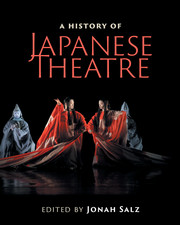Book contents
- Frontmatter
- Contents
- List of figures
- List of tables
- Contributors
- Contributors’ biographies
- Foreword
- Acknowledgments
- Note on Japanese terms
- List of abbreviations
- Timeline
- Editor's introduction
- I Traditional theatres
- Preface to Part I Japanese civilization arises
- II Modern theatres
- Preface to Part II
- III Arcs and patterns
- 12 Premodern playwriting practices
- 13 Traditional meta-patterns
- 14 Modern plays as literature
- 15 Modern meta-patterns
- Interlude Dōjōji: The lady and the bell
- IV Theatre architecture
- Preface to Part IV Evolution of Japanese theatre architecture
- V Theatre criticism
- VI Intercultural influences
- Epilogue: Frozen words and mythology
- Further reading
- Index
Interlude Dōjōji: The lady and the bell
from III - Arcs and patterns
Published online by Cambridge University Press: 05 July 2016
- Frontmatter
- Contents
- List of figures
- List of tables
- Contributors
- Contributors’ biographies
- Foreword
- Acknowledgments
- Note on Japanese terms
- List of abbreviations
- Timeline
- Editor's introduction
- I Traditional theatres
- Preface to Part I Japanese civilization arises
- II Modern theatres
- Preface to Part II
- III Arcs and patterns
- 12 Premodern playwriting practices
- 13 Traditional meta-patterns
- 14 Modern plays as literature
- 15 Modern meta-patterns
- Interlude Dōjōji: The lady and the bell
- IV Theatre architecture
- Preface to Part IV Evolution of Japanese theatre architecture
- V Theatre criticism
- VI Intercultural influences
- Epilogue: Frozen words and mythology
- Further reading
- Index
Summary
Meta-patterns of transformation, inter-textuality, and enduring visual symbolism are evident in the twistings of the Dōjōji tale – a woman's jealousy transforming her into an avenging serpent – through nearly all traditional and contemporary dramatic genres (Figure 53). The snake-lady shed her skin time and again, emerging in varying forms, responding to different performers’ needs and inspirations, and to widely disparate genre conventions. Originally a simple, anecdotal tale, “Dōjōji” was embellished, expanded, and situated in long, inventive multi-character, multi-plot stories to suit large-cast kabuki plays, and day-long puppet plays. Opposite to this elaboration was its distillation by creators of dance-drama such as noh or nihonbuyo. Their original poetry and choreography reframed the prose source story, extracting the essence from long heterogeneous plays: the emotional state of a single important character, the woman betrayed in love.
Hell hath no fury …
It all began innocently enough – just one of a thousand short tales in the twelfth-century Konjaku monogatari (Tales of times now past). Two monks, one old and one young and handsome, set out on a pilgrimage to Kumano Shrine. They stop at an inn where the proprietress, a young widow, falls in love with the young monk. She climbs into bed with him, but he is adamant in his vow of celibacy, saying he will be her lover after praying at Kumano. Yet he returns home via another route to avoid her; learning of his deceit, she shuts herself in her room and dies. Transformed into a 40-foot serpent, she slithers out in pursuit. The two priests take refuge in nearby Dōjōji Temple – the large temple bell is lowered over the young priest to conceal him. The serpent then “encircled the bell and tears of blood flowed from her eyes. The great bell of the temple blazed and was burned in the poisonous hot breath of the serpent. All that remained of the priest was a heap of ash.” Later, a senior monk organized a grand ritual reading of the Lotus Sutra, bringing salvation to the spirits of both woman and victim.
The famous tale becomes the back-story for a sequel set some years later in the noh Dōjōji (c. 1450, anonymous), the most dramatic play in the repertory, and one of the most popular (see Figure 56). A new bell is being dedicated at the temple and women are prohibited.
- Type
- Chapter
- Information
- A History of Japanese Theatre , pp. 411 - 416Publisher: Cambridge University PressPrint publication year: 2016

